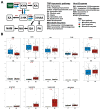Neurotransmitter Metabolic Disturbance in Methamphetamine Abusers: Focus on Tryptophan and Tyrosine Metabolic Pathways
- PMID: 39771127
- PMCID: PMC11728700
- DOI: 10.3390/toxics12120912
Neurotransmitter Metabolic Disturbance in Methamphetamine Abusers: Focus on Tryptophan and Tyrosine Metabolic Pathways
Abstract
Methamphetamine (METH) abuse disrupts the homeostasis of neurotransmitter (NT) metabolism, contributing to a wide range of neurological and psychological disorders. However, the specific effects of METH on NT metabolism, particularly for the tryptophan (TRP) and tyrosine (TYR) metabolic pathways, remain poorly understood. In this study, serum samples from 78 METH abusers and 79 healthy controls were analyzed using Ultra-High-Performance Liquid Chromatography with Tandem Mass Spectrometry (UHPLC-MS/MS). A total of 41 substances, primarily from the TRP and TYR metabolic pathways, were detected and subjected to multivariate analysis. Principal Component Analysis (PCA) and Partial Least Squares Discriminant Analysis (PLS-DA) revealed a significant separation of serum metabolites between METH abusers and controls, encompassing the disturbance of serotonergic, kynurenic, and microbial metabolism. In the serotonergic pathway, METH significantly reduced melatonin (MLT) levels and impaired the conversion of serotonin (5-HT) to N-acetylserotonin (NAS), a key precursor of MLT. In the kynurenic pathway, METH promoted a shift to the toxic metabolic pathway, evidenced by elevated levels of 3-hydroxykynurenine (3-HK) and quinolinic acid (QA). Furthermore, microbial metabolic pathway-related indole and its derivatives were markedly suppressed in METH abusers. Gender-specific differences were also observed, with NT metabolism in TRP and TYR pathways showing more pronounced alterations in male or female subgroups. Therefore, the current study provides a comprehensive overview of the disturbance in TRP- and TYR-associated NT metabolism caused by METH abuse and highlights NT metabolism as a promising therapeutic target for METH-induced neural and psychiatric disorders.
Keywords: methamphetamine; neurotransmitters; tryptophan metabolism; tyrosine metabolism.
Conflict of interest statement
The authors declare that they have no conflicts of interest.
Figures







Similar articles
-
Untargeted metabolomics analysis by gas chromatography/time-of-flight mass spectrometry of human serum from methamphetamine abusers.Addict Biol. 2021 Nov;26(6):e13062. doi: 10.1111/adb.13062. Epub 2021 Jun 10. Addict Biol. 2021. PMID: 34114299
-
[Quantitative analysis of tryptophan and its metabolites in urine by ultra performance liquid chromatography-tandem mass spectrometry].Se Pu. 2021 May;39(5):518-525. doi: 10.3724/SP.J.1123.2020.06022. Se Pu. 2021. PMID: 34227336 Free PMC article. Chinese.
-
Sex-specific metabolic signatures in methamphetamine addicts.Addict Biol. 2023 Jan;28(1):e13255. doi: 10.1111/adb.13255. Addict Biol. 2023. PMID: 36577725
-
The Engagement of Cytochrome P450 Enzymes in Tryptophan Metabolism.Metabolites. 2023 May 5;13(5):629. doi: 10.3390/metabo13050629. Metabolites. 2023. PMID: 37233670 Free PMC article. Review.
-
Methamphetamine-induced dopaminergic neurotoxicity: role of peroxynitrite and neuroprotective role of antioxidants and peroxynitrite decomposition catalysts.Ann N Y Acad Sci. 2001 Jun;939:366-80. doi: 10.1111/j.1749-6632.2001.tb03646.x. Ann N Y Acad Sci. 2001. PMID: 11462792 Review.
References
-
- Zhang K., Chen L., Yang J., Liu J., Li J., Liu Y., Li X., Chen L., Hsu C., Zeng J., et al. Gut Microbiota-Derived Short-Chain Fatty Acids Ameliorate Methamphetamine-Induced Depression- and Anxiety-like Behaviors in a Sigmar-1 Receptor-Dependent Manner. Acta Pharm. Sin. B. 2023;13:4801–4822. doi: 10.1016/j.apsb.2023.09.010. - DOI - PMC - PubMed
Grants and funding
LinkOut - more resources
Full Text Sources
Research Materials

